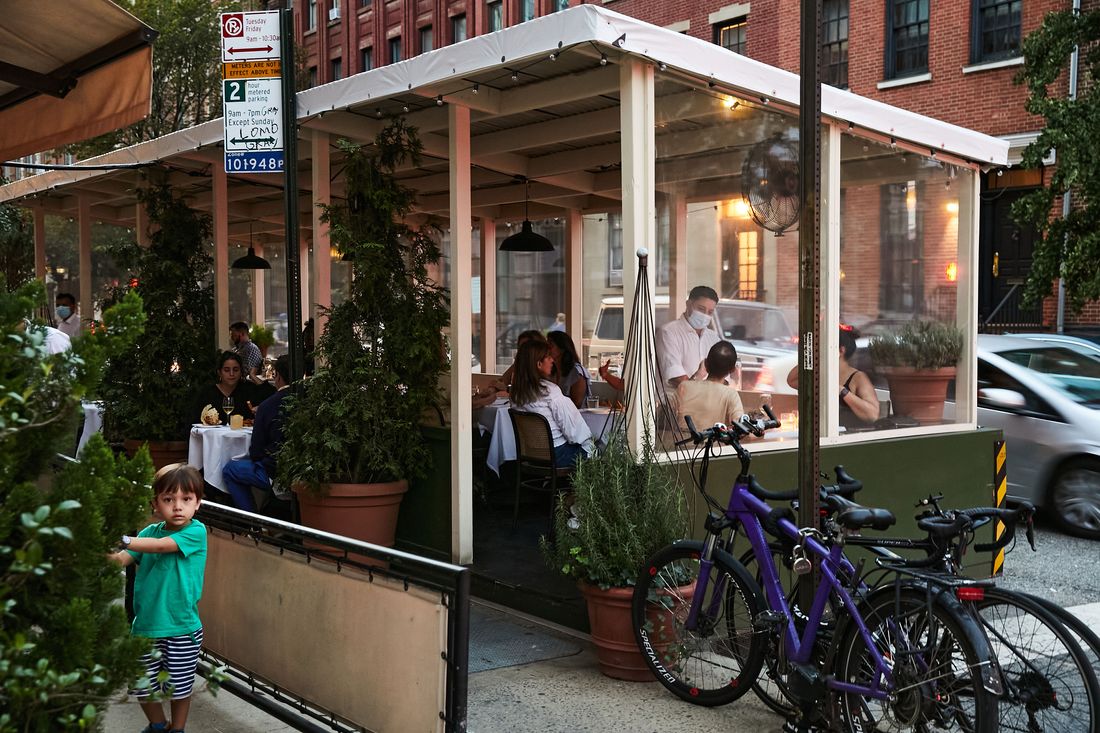
After New York moved to allow its restaurants to build freestanding structures on city streets to house diners when it was unfathomable to be inside a room with strangers, there was always going to come a time when those sheds became less necessary and we had to decide what we’d do about them. That time is now, unfortunately, and it has become clear that everyone in the city hates everyone else’s ideas.
How do I know this? Because I tuned in to Tuesday’s City Council hearing, which was convened to discuss a bill that would make the program, officially known as Open Restaurants, permanent. The meeting lasted eight hours 40 minutes with 250 people testifying for or against the program. It was the spiciest, most riveting bureaucratic marathon I’ve ever witnessed, and I say that knowing full well I could have rewatched the last season of Search Party twice in the amount of time it took to view this hearing.
Here is where things stand right now: In late 2020, the City Council voted to make the program permanent. Then in November 2021, the City Planning Commission voted for an amendment that would remove restrictions on outdoor dining, paving the way — pending final City Council and mayoral approval — for Open Restaurants to actually become permanent. Under the new legislation, the program would be overseen by the Department of Transportation. Business owners who want to partake would be charged an initial fee of $1,050 and a $525 annual fee thereafter. And the various structures that have gone up — sheds, yurts, plywood chalets — would have to come down. According to Julie Schipper, the director of Open Restaurants, only umbrellas, tents, and barriers would be allowed for roadway streeteries. Thirty staffers would be hired for the program, and all operators would have to reapply anew. “We will not be grandfathering in any of the current restaurants and their structures,” Schipper stated during Tuesday’s hearing.
The point on which people seem to agree is the plan served its purpose. “It’s been successful for the restaurateurs, for sure,” argued Kalman Yeger, who represents parts of southern Brooklyn. “They’ve been able to increase the size of their space, not pay real property tax on it, not pay rent on it, and have the ability to get free space courtesy of NYC.” (Paul Italia, who runs a comedy club and a sandwich shop, testified that he thinks one often-cited figure — that the program saved 100,000 jobs — “is probably on the low side.”)
The sticking point is that, as diners feel increasingly comfortable indoors, many operators have moved on from their sheds but haven’t actually gotten around to taking them down, instead finding all sorts of industrious new uses for the big, empty spaces. One Lower East Side resident testified Tuesday that a streetery in his neighborhood has become “nothing more than a front that hides the parking space used by the restaurant owner so it is available to him when he arrives.” Other critics say they see structures being used as expanded storage space.
So who’s going to make sure these things actually get removed? That responsibility would fall to the DOT, which isn’t exactly moving at a breakneck pace. “I’m deeply concerned about this process and some of the answers we don’t have,” Bronx councilmember Amanda Farías said, citing a statistic that the city has issued 4,000 warnings for improper streetery usage but has removed only 24 structures. The idea that just 30 additional employees will be sufficient was met with mockery by some. “Thirty people could do one district,” said Gale Brewer, the former Manhattan borough president who now represents the 6th District, “and you could still have problems.” Spoiler: There will be problems.
But hey, other critics wonder, while we’re talking about reallocating this space, why are we only talking about restaurants and bars? “Let’s reimagine how we use our streets,” said Community Board 2 member Jeannine Kiely. “But it only benefits one industry … The city is not considering alternative uses for these spaces.” She makes a valid point. After all, has anyone considered that we could be turning these spaces into individual SoulCycle studios or pickleball courts?
“We need to get this right” was the big takeaway from the meeting, which, to reiterate, lasted longer than the combined running times of all four Jackass movies. We don’t want unkempt sheds to blight our streets. We need to ensure these outdoor spaces are accessible to disabled customers. We don’t want outdoor dining to be a perk that only benefits wealthy operators and neighborhoods, which it was before Open Restaurants when sidewalk cafés barely existed in the Bronx. And nobody wants outdoor dining to turn into “the Wild West of drinking in the streets and vomit and chaos,” as bar owner Megan Rickerson put it during the meeting. (The pro-chaos contingency presumably couldn’t get organized in time to make its voice heard.)
As the hearing finally wound down, what was clear was some people like some aspects of this program. Other people like other aspects. And it will now be the charge of the DOT to figure out exactly which parts stay and which will go. It will be, in the words of City Council Speaker Adrienne E. Adams, “a monumental lift,” and no matter what it decides, all of New York will probably hate the result.





